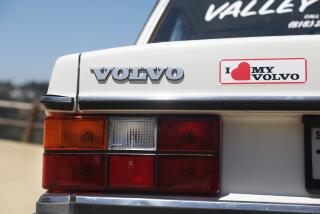When clunkers become classics
MONTEREY, CALIF. — The moment of clarity for me came Sunday, the second night of the Gooding & Co. classic car auction.
On the block was a 1971 Chevrolet Monte Carlo, as wretched and routine a hunk of Detroit iron as ever freighted down an assembly line. Spot-welded together with the craftsmanship one might expect of unsupervised political prisoners, the Monte Carlo -- with a 402-cubic-inch V8 engine and four-barrel carburetor -- was and is a sidewalk-fumigating stink bomb, with no steering or handling to speak of, and brakes that are more rumor than fact.
This particular car was a cut above, with fine black Naugahyde and adhesive-backed wood-grain on the dash. Still, in my college days I could have bought Monte Carlos like this for $500 all day long. At Gooding, the car sold for $60,500. Good Lord. The clunkers of my youth have become classics.
As the government’s “cash for clunkers” program rides into the stimulus sunset, the consensus seems to be that although the rules might have been more expertly crafted, the program was wildly successful, helping to move nearly a half-million vehicles off dealer lots in a few weeks and getting thousands of gas hogs off the road.
And as my colleagues Ralph Vartabedian and Ken Bensinger reported, the classic car industry managed to craft the rules so that no car made before 1984 -- potential collectibles -- would qualify. The nation was thus spared the tragedy of seeing, say, a ’79 Buick Regal two-door coupe being euthanized. After all, Buick only made 273,375 of them that year.
But having sat in on a few classic car auctions in Monterey last weekend during the annual buildup to the Pebble Beach Concours d’Elegance, I was struck by how arbitrary and clumsy the 25-year rule is, and what a moving target the notion of classicism is.
Yes, it does seem unlikely that future car collectors will covet a 1989 Geo Metro, a rinky-dink little sardine can that General Motors and Suzuki made by the millions. And it is certainly true that the last quarter-century of car building has been a period of unusual gracelessness.
American cars in particular weren’t so much manufactured as excreted, cost-squeezed and homogenized and ambered in their own mediocrity. Think about it: Chrysler Town & Country minivan, Mercury Tracer, Ford Mustang 5.0, Pontiac Grand Am -- terrible cars made in staggering numbers. How could they ever be collectible, much less classic?
Then again, a few years ago, no one would have predicted that the robustly awful 1971 Plymouth Duster would make it to the block at the prestigious Bonhams & Butterfield’s auction in 2009. My father would have howled at the idea that his 1939 Ford DeLuxe station wagon would have ever been collected by anyone who wasn’t in the scrap iron business. Last week, one rolled across RM Auctions’ stage.
As a traumatized veteran of several British sports cars, I nearly keeled over at the prices some of these cars were getting (RM sold a 1939 MG TA Tickford Drophead coupe for $132,000 and ’62 Triumph TR3 for $44,000).
So you just never know what will bubble up through car consciousness to be declared desirable and collectible, which cars will bottle a moment and a mood or a technology, which will become important to people.
As for the “cash for clunkers” post-1984 rule, I think it’s a pretty blunt instrument that probably resulted in many future collectibles being consigned to the scrap yard. Here’s a list of clunkers that deserve better. All have a trade-in value of less than $4,500, according to Kelly Blue Book, with average mileage and in good condition.
* 2001 Pontiac Aztek: The irradiated toad of GM’s crossover program, the Aztek has the same collectible cachet as the Ford Edsel and footage of the Hindenburg at Lakehurst: Everybody loves to have a little piece of disaster. Dirtiest secret? The Aztek was actually pretty useful to drive. Totally collectible, if any are left.
* 1993 Cadillac STS with Northstar engine: This was the first glimmer of hope that Cadillac could be turned around. The Northstar was GM’s first proper, modern, dual-overhead cam engine and the STS’ clean, modern styling was first-rate. If you see one on the road today, you’ll see. Future classic, for sure.
* 1994 Mercedes-Benz S320 Sedan: They don’t build them like this anymore. I mean, they really don’t. The W140 chassis S-Class was one of the last Benz models built in the engineering-first, cost-be-damned culture of Stuttgart. A huge brute of a car, built like a tank, designed to last a lifetime. It will be a six-figure car in 2025, but you can probably pick one up today for $3,300.
* 1989 Ford Taurus SHO: A domestic front-wheel-drive sedan on amphetamines, the SHO (Super High Output) was powered by a feisty Yamaha dual-cammer and a five-speed manual gearbox. One of the most spectacular torque-steerers ever built, the SHO was rude, crude and a ton of fun at a time when “Ford” and “sedan” spelled “sleepytime.”
* 1994 Buick Roadmaster sedan: Some Americans are just plain big. Yes, fat, but also just hefty, tall, former-football player big. And there are very few cars out there that can accommodate a 6-foot-6, 300-pound man. The Roadmaster is one. This model year came with a de-tuned Corvette engine (260 hp) and enough legroom to stage a dance recital. I predict the big-and-tall market will make the Roadmaster an enduring classic.
As used cars, agreed, these are sort of dismal and commodified, just more sheet metal in a world drowning in cars. The crusher might seem a fitting end. But each of these cars was loved by somebody at some point and, if they survive, will be loved again.
--






